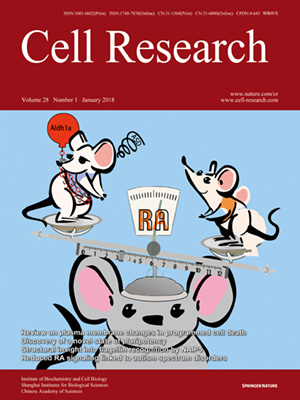
Volume 28, No 1, Jan 2018
ISSN: 1001-0602
EISSN: 1748-7838 2018
impact factor 17.848*
(Clarivate Analytics, 2019)
Volume 28 Issue 1, January 2018: 111-125
ORIGINAL ARTICLES
Landscape of the regulatory elements for lysine 2-hydroxyisobutyrylation pathway
He Huang, Zhouqing Luo, Shankang Qi, Jing Huang, Peng Xu, Xiuxuan Wang, Li Gao, Fangyi Li, Jian Wang, Wenhui Zhao, Wei Gu, Zhucheng Chen, Lunzhi Dai, Junbiao Dai & Yingming Zhao
Correspondence:
Short-chain fatty acids and their corresponding acyl-CoAs sit at the crossroads of metabolic pathways and play important roles in diverse cellular processes. They are also precursors for protein post-translational lysine acylation modifications. A noteworthy example is the newly identified lysine 2-hydroxyisobutyrylation (Khib) that is derived from 2-hydroxyisobutyrate and 2-hydroxyisobutyryl-CoA. Histone Khib has been shown to be associated with active gene expression in spermatogenic cells. However, the key elements that regulate this post-translational lysine acylation pathway remain unknown. This has hindered characterization of the mechanisms by which this modification exerts its biological functions. Here we show that Esa1p in budding yeast and its homologue Tip60 in human could add Khib to substrate proteins both in vitro and in vivo. In addition, we have identified HDAC2 and HDAC3 as the major enzymes to remove Khib. Moreover, we report the first global profiling of Khib proteome in mammalian cells, identifying 6 548 Khib sites on 1 725 substrate proteins. Our study has thus discovered both the “writers” and “erasers” for histone Khib marks, and major Khib protein substrates. These results not only illustrate the landscape of this new lysine acylation pathway, but also open new avenues for studying diverse functions of cellular metabolites associated with this pathway.
10.1038/cr.2017.149
FULL TEXT | PDF
Browse 1769


